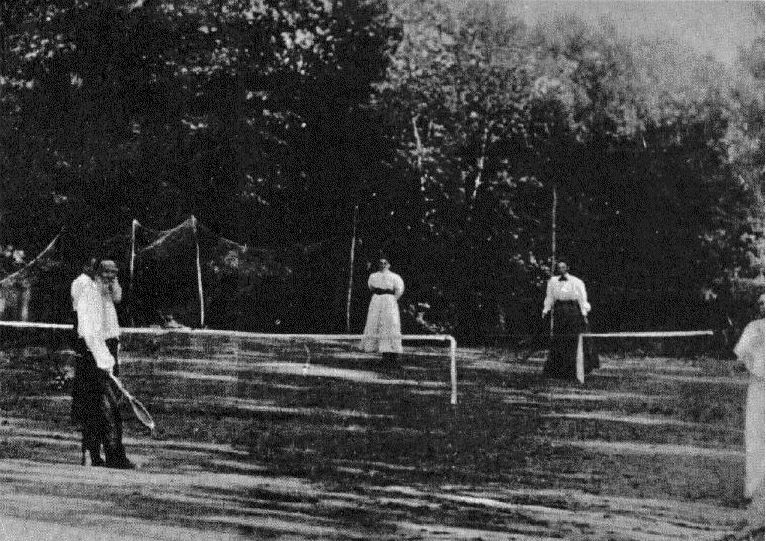Tuesday
My son Toby alerted me to this New Yorker article on Tolstoy and tennis. As I’m currently listening to Tolstoy’s novel Resurrection while fervently hoping that Roger Federer will win the U.S. Open, all the pieces came together for today’s blog post.
Gerald Marzorati sets out to solve a puzzle. On the one hand, photographs exist of Tolstoy with a racquet in his hand and appearing to enjoy the game. On the other hand, Tolstoy at one point in his life had contempt for tennis. Marzorati figures this out from reading Anna Karenina:
When he was in his forties, he thought tennis was a faddish luxury, a pastime of the new rich, something imported, inauthentic—a child’s game enthused about by well-to-do grownups who refused to grow up. We know this from Part 6, Chapter 22, of Anna Karenina, which he was writing in the eighteen-seventies, when the modern game of “lawn tennis” was developed and patented by Major Walter Clapton Wingfield, a British Army officer. [A set of Wingfield’s tennis equipment]—imaginatively—winds up on the “carefully leveled and rolled croquet-ground” of the house where Tolstoy’s Anna, having left her husband and son and shocked Moscow society, has gone to live with her lover, Vronsky, and where, at this juncture late in the novel, she is being visited by her sister-in-law, Dolly, her last real defender in the world that she has abandoned—and that has abandoned her.
Dolly, embodying Tolstoy’s point of view, is appalled by what she sees:
Before long, it is mostly the men who are playing: running, laughing, shouting, perspiring in their frock coats…Watching them, Dolly senses her mood darkening. The “unnaturalness of grown-ups when they play at a children’s game by themselves, without children,” has made her unhappy. And the tennis gets her to thinking that the players she’s watching are players off the court, too—that Vronsky and his friends are new types, modern bourgeois strivers who are in all aspects of their lives “actors,” and for whom all settings are essentially “theatre.”
Marzorati reflects,
You’d think, from all this, that Tolstoy despised tennis and all he thought it represented. If he did, wouldn’t his scorn deepen as he aged, withdrew, and lost himself in deep-going ethical ponderings?
By the end of his life, however, Tolstoy took up tennis. He also took up bicycling, which some of his friends and followers found to be
silly and even un-Christian: How did it square with all the renouncing of the material world that he was doing? And he a spiritual leader, a sage: What was he doing peddling around like a child? One can only imagine what they thought of his tennis.
Here’s Marzorati’s explanation:
Tolstoy addressed these concerns in his diaries. Reading them, it struck me that Tolstoy was now justifying himself as Vronsky, writing in a diary after his post-dinner tennis match, might have done twenty years earlier, if Vronsky had been a self-conscious sort wrestling with himself before sleep, which he wasn’t. Tolstoy wanted to work his body. He wanted to try new things. He saw the possibility of pleasures and satisfactions in physical activity. “There is nothing wrong,” he wrote to himself, “with enjoying oneself simply, like a boy.” Tolstoy, the old, earnest essayist, the death-haunted contemplator of Big Things, still wanted to play.
In Resurrection, written around the time of the above photograph, protagonist Nekhlyudov turns his back on his rakish ways when he realizes that he has led a young woman into a life of sin. His new seriousness means that he now shuns his former companions—versions of Vronsky—who attend horse races, drink freely, and run up debt. Instead, he thinks of ways he can reform the prisons and empower the peasants on his estate. He is appalled that he once lived a frivolous life.
Nekhlyudov wants to return to a time when he played innocent games with Katusha, the woman he ruined, as described in the following passage:
But on Ascension Day that summer, a neighbour of his aunts’, and her family, consisting of two young daughters, a schoolboy, and a young artist of peasant origin who was staying with them, came to spend the day. After tea they all went to play in the meadow in front of the house, where the grass had already been mown. They played at the game of gorelki, and Katusha joined them. Running about and changing partners several times, Nekhludoff caught Katusha, and she became his partner. Up to this time he had liked Katusha’s looks, but the possibility of any nearer relations with her had never entered his mind.
“Impossible to catch those two,” said the merry young artist, whose turn it was to catch, and who could run very fast with his short, muscular legs.
“You! And not catch us?” said Katusha.
“One, two, three,” and the artist clapped his hands. Katusha, hardly restraining her laughter, changed places with Nekhludoff, behind the artist’s back, and pressing his large hand with her little rough one, and rustling with her starched petticoat, ran to the left. Nekhludoff ran fast to the right, trying to escape from the artist, but when he looked round he saw the artist running after Katusha, who kept well ahead, her firm young legs moving rapidly. There was a lilac bush in front of them, and Katusha made a sign with her head to Nekhludoff to join her behind it, for if they once clasped hands again they were safe from their pursuer, that being a rule of the game.
So Marzorati is right. Tennis taps into the spirit of innocent youth, which Tolstoy saw as the foundation of what is best in us.


